|
[Development]
Lanka moves up World Bank Index:
Positive developments reap dividends
By Shirajiv SIRIMANE
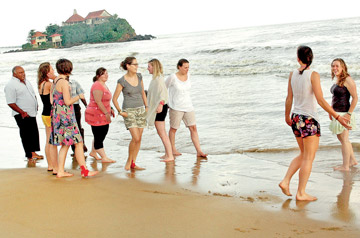 When President Mahinda Rajapaksa's Mahinda Chinthana asked the masses
to 'repose faith in him' to take the country on the path to be the
'Wonder of Asia', some considered it as another 'election promise'. When President Mahinda Rajapaksa's Mahinda Chinthana asked the masses
to 'repose faith in him' to take the country on the path to be the
'Wonder of Asia', some considered it as another 'election promise'.
In the first instance, many both locally and globally believed that
the Government would never be able to end the 30-year terrorism.
When peace was achieved with the world's biggest humanitarian
operation, the world was astonished as superpowers were spending
trillions of dollars in their battle to end terrorism, to no avail.
The world also believed that Sri Lanka would take at least five years
to clear the 336,000 deadly landmines that were laid, but this too was
completed in two years at the rate of 500 mines per day. Next the world
focused on the resettlement of the 300,000 displaced persons; this
target too was successfully achieved in two years.
The country also achieved an eight percent growth rate and doubled
its per capita income within five years.
For almost two decades, key development projects such as the
Norochcholai power plant, Upper Kotmale hydro power project, Hambantota
and Oluvil Ports and the Colombo South Harbour development projects,
Colombo-Matara expressway and the building of a second international
airport were confined to discussions and plans.
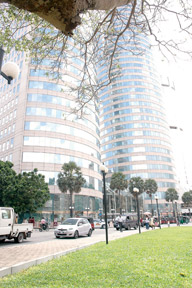 |
|
World Trade Center area |
After almost 30 years, the subject of an expressway to the Colombo
Airport was discussed and in 2000 a consortium once again got off the
ground. However, this time around too, financial constraints put
barricades to the project and it was stalled again. With the rapid
expansion of the Colombo Airport and tourism booming, quick access to
the Colombo Airport was a crying need. VVIPs, investors, tourists as
well as the public do not have nearly two hours to waste, travelling
from Colombo to the airport.
Major projects
However, after Mahinda Rajapaksa was elected President, all these
projects got off the ground. Some major projects such as Norochcholai
was completed and the first stage of the Colombo-Matara Highway up to
Galle would be opened this year while the rest of the project would be
completed next year.
The Colombo South Harbour is being developed under the Port
Development Project and the second and third phases of the Colombo Port
Development Project will enhance the total capacity upto 13 million TEUs
with each terminal having a 2.4 million TEU capacity.
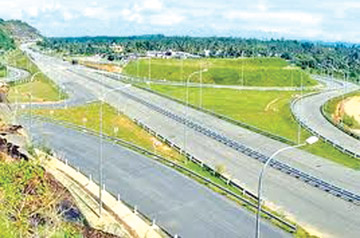
The Colombo-Matara Highway |
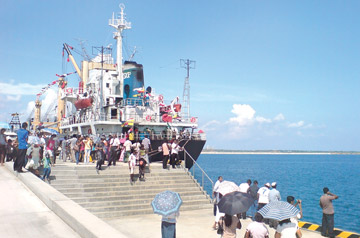
Hambantota Port |
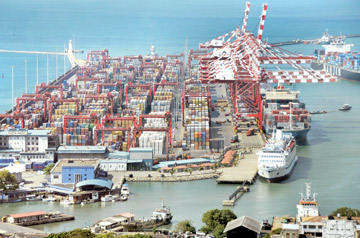
Colombo Harbour |
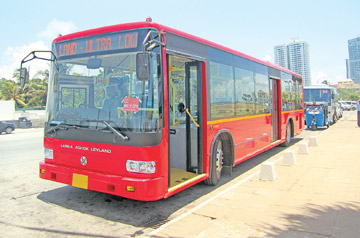
A new bus from Ashok Leyland which has wheelchair accessibility |
Construction work of Phase II of the Hambantota Mahinda Rajapaksa
Port is ready to get under way and under this phase, it is expected to
deepen the channel further and add six more berths including a container
terminal.
On a proposal made by Minister of Industry and Commerce, Rishad
Bathiudeen a dedicated industrial zone for manufacturing of
pharmaceutical products is to be established in Kurunegala at a 48-acre
block of land to promote the local pharmaceutical industry.
The value of pharmaceutical products annually consumed in the country
is Rs. 40 billion and the Government is the biggest consumer,
representing well over 35 percent of the domestic consumption. It is
around Rs.15 billion.Over 10 reputed pharmaceutical manufacturers have
already expressed their willingness to invest in this industry.
The Colombo International Airport's domestic terminal will be opened
next March, mainly cater to the growing domestic air traffic market in
Sri Lanka.
Domestic terminal
Chairman, Airport and Aviation Services (AASL), Prasanna
Wickramasuriya told the Sunday Observer that they were converting the
former SriLankan Airlines catering building for this purpose. "AASL
would invest Rs. 250 million for this domestic terminal," he
said.Wickramasuriya said with tourism picking up and high spenders
patronising Sri Lanka and investment and development taking place in the
regions, the demand for domestic travel had increased.
In addition much needed infrastructure by way of roads, transport,
health and other key factors too were falling into place.
Economy-friendly legislature was introduced which has made Sri Lanka
an investment paradise. Sri Lanka made paying taxes less costly for
businesses by abolishing the turnover tax and social security
contribution and by reducing the rate of corporate income tax, value
added tax and nation building tax.
Sri Lanka Ports Authority (SLPA) Chairman Dr. Priyath B. Wickrama
said the Colombo Port and the Ruhunu Magampura Mahinda Rajapaksa
International Port in Hambantota will attract over US$ five billion in
investments through the private sector by 2015. Over US$ three billion
has already been invested in the port sector through funds from Asian
Development Bank, People's Republic of China, India, Denmark and Japan.
"Other than this, private sector organisations from various countries
have committed to invest a total of US$ 2.2 billion in the areas of
manufacturing, assembling, warehousing and handling," he said.
He said they have already received offers worth US$ 1.2 billion to
invest in the Port of Colombo and around US$ one billion for the
Hambantota Port. It has been estimated that distribution of Asian
container volumes will be 55 percent from East Asia, 18 percent from
South East Asia, 14 percent from North Asia, 9 percent from South Asia
and four percent from West Asia including the Middle East.
Global ranking
These efforts have not gone unnoticed with the World Bank placing Sri
Lanka in the 89th position in the global ranking from 183 countries, as
one of the best places to do business on the 'Doing Business Index.' The
Maldives is ahead of Sri Lanka in the ranking and India finished at
132nd position while Pakistan (105), Nepal (107), Bangladesh (122),
Bhutan (142) and Afghanistan (160) were also behind Sri Lanka.
This achievement again clearly underlines the investor confidence the
international community has for Sri Lanka. The Ceylon Chamber of
Commerce (CCC) said they were pleased that Sri Lanka has taken a quantum
leap in its overall ranking in the 'Doing Business Index' of the World
Bank. Sri Lanka has risen nine points from 98/183 last year to become
89/183, sending out positive signals for investors and the business
community.
"There has been a remarkable increase in some key areas such as
dealing with construction permits, protecting investors and trading
across borders.
The country has risen from 169th position to 111th position with
regard to dealing with construction permits for 2012 while in protecting
investors Sri Lanka is ranked in the 46th position as opposed to the
74th position for 2011.
The country also stands at the 53rd position in trading across
borders for 2012. These achievements on the part of the country indicate
that the peace dividend has indeed paid off and the efforts made by the
authorities to improve our ranking have borne positive results," the CCC
said.
The Doing Business Index analyses regulations that apply to an
economy's businesses during their life cycle, including start-up and
operations, trading across borders, paying taxes, and resolving
insolvency.
The aggregate ease of doing business rankings are based on 10
indicators and cover 183 economies. |

